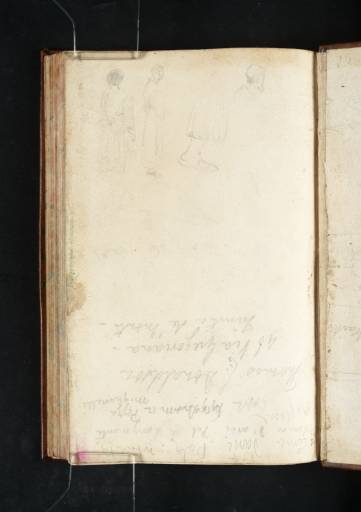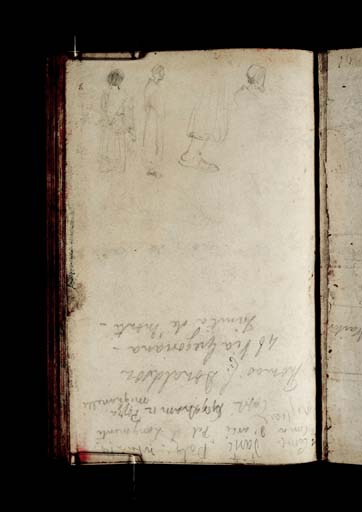Joseph Mallord William Turner Studies of Monks; and Inscriptions of Italian Phrases and Addresses in Rome 1819
Image 1 of 2
Joseph Mallord William Turner,
Studies of Monks; and Inscriptions of Italian Phrases and Addresses in Rome
1819
Joseph Mallord William Turner 1775–1851
Folio 82 Verso:
Studies of Monks; and Inscriptions of Italian Phrases and Addresses in Rome 1819
D15250
Turner Bequest CLXXX 81 a
Turner Bequest CLXXX 81 a
Pencil on white wove paper, 161 x 101 mm
Inscribed by the artist in pencil ‘i Coma darsi Pola . [...]’ and ‘Coma d’arsi Pal S Longmente | [?Inglese]’ and ‘Capt Graham 12 Pizza | Mignanelli’ across bottom, inverted
Inscribed by Thomas Donaldson ‘Thomas L. Donaldson | 46 Via Gregoriana – | Trinita de’Monti-’ underneath first inscription at bottom, inverted
Inscribed by Thomas Donaldson ‘Thomas L. Donaldson | 46 Via Gregoriana – | Trinita de’Monti-’ underneath first inscription at bottom, inverted
Accepted by the nation as part of the Turner Bequest 1856
References
1897
Walter Thornbury, The Life of J.M.W. Turner, R.A. Founded on Letters and Papers Furnished by his Friends and Fellow-Academicians: A New Edition, Revised with 8 Coloured Illustrations after Turner’s Originals and 2 Woodcuts, London 1897, p.478.
1909
A.J. Finberg, A Complete Inventory of the Drawings of the Turner Bequest, London 1909, vol.I, p.534, as ‘Various figures, also – “Capt. Graham, 12 Pizza Mignanelli” and “Thomas L, Donaldson, 46 Gregoriana, Trinita de’Monti” ’.
1925
Thomas Ashby, Turner’s Visions of Rome, London and New York 1925, pp.12–13.
1968
John Gage, ‘Turner’s Academic Friendships: C.L. Eastlake’, Burlington Magazine, vol.110, 1968, p.678.
1980
John Gage, Collected Correspondence of J.M.W. Turner with an Early Diary and a Memoir by George Jones, Oxford 1980, pp.103 no.119 note 1, 118 no.140 note 1.
1984
Cecilia Powell, ‘Turner on Classic Ground: His Visits to Central and Southern Italy and Related Paintings and Drawings’, unpublished Ph.D thesis, Courtauld Institute of Art, University of London 1984, pp.183, 474 note 25, 494 note 58.
1984
Cecilia Powell, ‘Turner and the Bandits: ‘Lake Albano’ rediscovered’, Turner Studies, Summer 1984, vol.3, no.2, p.27 note 13.
1987
John Gage, J.M.W. Turner: ‘A Wonderful Range of Mind’, New Haven and London 1987, p.65.
1987
Cecilia Powell, Turner in the South: Rome, Naples, Florence, New Haven and London 1987, p.81 note 47.
1997
James Hamilton, Turner: A Life, London 1997, pp.200, 325 note 23.
2008
James Hamilton, Nicola Moorby, Christopher Baker and others, Turner e l’Italia, exhibition catalogue, Palazzo dei Diamanti, Ferrara 2008, pp.45 and 90 note 34 [incorrectly as inside back cover].
2009
James Hamilton, Nicola Moorby, Christopher Baker and others, Turner & Italy, exhibition catalogue, National Galleries of Scotland, Edinburgh 2009, pp.44, 151 note 34 [incorrectly as inside back cover].
Turner’s principal use for the Vatican Fragments sketchbook was to record details of art and architecture in Rome. However, he also made several studies of figures from life. At the top of this page are four studies of monks, showing the same or different man from the back, the side, a detail of a foot in a sandal and a head in profile. Further sketches of people can be found on the inner front cover and on folios 6 verso, 14 verso, 15 verso, 33 verso, 64, 69, 80, 80 verso, 82 and 82 verso (D40619, D15114, D15130, D15132, D15167, D15223, D15228, D15245, D15246, D15249 and D15250; Turner Bequest CLXXX 5a, 13a, 14a, 32a, 63, 68, 79, 79a, 81 and 81a).
Inverted at the bottom of the page are also a number of written inscriptions. The artist has used the sheet to jot down some Italian phrases to help him negotiate his way around Rome. As Cecilia Powell has noted Turner was unable to speak Italian and therefore relied on guide books and help from acquaintances.1 He was later described by a contemporary as speaking ‘but a few words of Italian, about as much of French, which two languages he jumbles together most amusingly’.2
There are also two Roman addresses which provide rare documentary evidence of Turner’s movements during his 1819 tour of Italy. The first refers to Captain Thomas Graham, RN (died 1822) and his wife, Maria (1785–1842, later Lady Callcott), an amateur artist and writer whom Turner later referred to as ‘a very agreeable Blue Stocking’.3 The Grahams rented a house from a sculptor, Giuseppe Ugo, at 12 Piazza Mignanelli, near the Piazza di Spagna and the Spanish Steps, an area which represented the heart of the English community in Rome.4 A studio at the same address was also used by the painter, Charles Lock Eastlake (1793–1865). Although it is not known where Turner stayed during his 1819 sojourn in Rome, it is feasible that he too found accommodation in the vicinity, and on his second trip to the city in 1828 it was this same studio which he shared with Eastlake, and from where he painted three finished oil pictures, View of Orvieto, (Tate, N00511), Vision of Medea 1828 (Tate, N00513), and Regulus 1828 (Tate, N00519).5 It was almost certainly Eastlake who introduced Turner to the Grahams. Earlier in the year, the younger artist had accompanied the couple on a trip to Poli, near Tivoli, an account of which later appeared in Maria Graham’s best-selling book, Three Months Passed in the Mountains East of Rome, during the year 1819, published 1820. The book, which contained a description of the lives of the Italian brigands or banditti operating within this part of the country, was illustrated by aquatints after drawings by Eastlake, and led to a vogue for romanticised images of banditti and peasant women or contadine. Cecilia Powell has suggested that it was this popular genre which Turner referenced within his finished watercolour, Lake Albano 1828 (private collection),6 and that the foreground figure of the artist being accosted by the couple in contemporary rustic costume may even be a portrait of Eastlake himself.7 The presence of the Piazza Mignanelli address in one of Turner’s sketchbooks is a strong indication that the artist had some contact with fellow English tourists during his time in Rome, and that he probably socialised with both the Grahams and Eastlake on at least one occasion.
The second address on this page refers to Thomas Leverton Donaldson (1795–1885), an architectural student from the Royal Academy, who was staying at 46 Via Gregoriana, a road which leads south-east from Trinità dei Monti and the top of the Spanish Steps towards the Quirinal Hill. Turner is likely to have first met Donaldson in Naples, accompanying him on the ascent of Vesuvius and later joining him again to dine with him at the British Minister.8 Powell has established that the Roman address in this sketchbook was written by Donaldson himself so it is possible that the two met again back in the capital.9
Nicola Moorby
December 2009
How to cite
Nicola Moorby, ‘Studies of Monks; and Inscriptions of Italian Phrases and Addresses in Rome 1819 by Joseph Mallord William Turner’, catalogue entry, December 2009, in David Blayney Brown (ed.), J.M.W. Turner: Sketchbooks, Drawings and Watercolours, Tate Research Publication, December 2012, https://www


